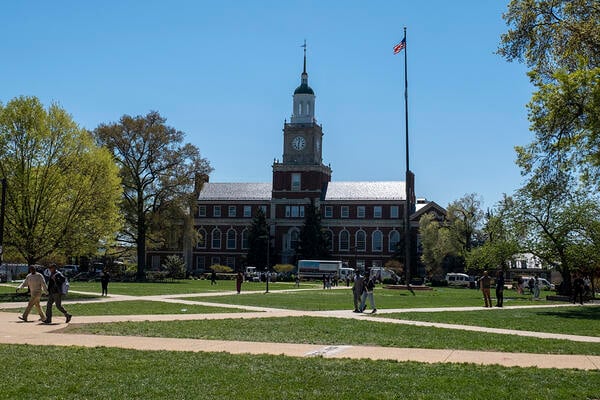
ED Reallocates MSI Funding to HBCUs, Tribal Colleges
When the U.S. Department of Education abruptly ended grants for most minority-serving institutions last week, it raised questions about what the department would do with the hundreds of millions of dollars already slated for these programs. The department offered an answer Monday, announcing plans to repurpose funds from programs “not in the best interest of students and families” to historically Black colleges and universities, tribal colleges, charter schools, and civics education.
“The department has carefully scrutinized our federal grants, ensuring that taxpayers are not funding racially discriminatory programs but those programs which promote merit and excellence in education,” Education Secretary Linda McMahon said in a statement. “The Trump Administration will use every available tool to meaningfully advance educational outcomes and ensure every American has the opportunity to succeed in life.”
The department promised to direct an extra $495 million to HBCUs and tribal colleges, on top of the funds already anticipated for fiscal year 2025—increases of 48.4 percent and 109.3 percent, respectively. In total, HBCUs are slated to receive over $1.34 billion and tribal colleges expect to receive $108 million this fiscal year, which ends Sept. 30. The department is also giving an additional $60 million to charter schools and putting $137 million toward civics education grants. The department didn’t share more specifics on how it would allocate the funds to institutions.
The move has been met with mixed reactions. Some HBCU advocates are celebrating the one-time influx as a game-changer for cash-starved institutions. Others’ joy is tempered by concern that the Trump administration is uplifting some MSIs at the expense of others, sowing tensions between them.
The new funds come less than a week after the Education Department quashed grant programs for Hispanic-serving institutions and other MSIs, deeming them “unconstitutional” because they require colleges to serve a certain percentage of students from a particular racial or ethnic background to qualify. (HBCUs and tribal colleges don’t have enrollment thresholds.) This blow to MSI grants, as well as cuts to teacher prep and gifted and talented programs, is paying for the department’s recent largess, The New York Times reported, citing several anonymous sources familiar with the department’s plans.
Lodriguez Murray, vice president of public policy and government affairs at the United Negro College Fund, which represents private HBCUs, said the funds are “nothing short of a godsend” for institutions operating on lean budgets.
“Now, all of a sudden, [HBCUs] have much more wherewithal to do the things, not just that take you from year to year, but can make an impact on your campus,” he said. He foresees HBCUs using the funds to buy property, improve their campus infrastructure and invest in student and faculty supports in new ways.
Murray said he doesn’t have qualms about the money coming from the slashed MSI programs.
He claimed many of these institutions are predominantly white, tend to have higher endowments than HBCUs and serve lower shares of Pell-eligible students. (Most enrollment-based MSIs are required to serve at least 50 percent low-income students. HBCUs have no such requirement but tend to enroll at least 70 percent Pell-eligible students.)
As far as he’s concerned, the Trump administration is channeling “resources toward the institutions that seem to need it the most—and the institutions that have a better track record at taking students from underserved backgrounds and … changing the economic outlook of their lives,” Murray said. “That is the reason why we have no pause about receiving the funds this morning.”
Harry Williams, president and CEO of the Thurgood Marshall College Fund, which represents public HBCUs, said he wants to see other types of MSIs thrive, and at the same time, he’s excited about how the new support could help HBCU students.
He didn’t know the Trump administration planned to drop millions on the institutions, he said. And while TMCF regularly lobbies for HBCU funding, “candidly, we have never made any recommendations about where the money should come from to the administration, because that’s their decision in terms of how they operate.”
He said he’s “sensitive” to the challenges facing MSIs, noting that TMCF has three predominantly Black institutions among its members. TMCF put out a statement last week in support of them when the department said it was ending MSI grant programs, including PBIs.
“We do support MSIs and PBIs and all the groups in that category and recognize the importance of them having resources, too,” he said, “but our primary focus has always been working with HBCUs.”
Pitting MSIs Against Each Other
Marybeth Gasman, executive director of the Rutgers Center for Minority Serving Institutions, said HBCUs and tribal colleges deserve the money.
These institutions have “always been underfunded” and “the federal government should always be thinking about ways to enhance them, especially based on our country’s history of racism and inequities,” she said.
But Gasman believes other types of MSIs are also deserving of these resources. She pointed out that many Hispanic-serving institutions are community colleges, and they serve about a third of the country’s students over all, not just Latino students.
The Education Department is “trying to pit different types of minority-serving institutions against each other,” even though MSI leaders and advocacy groups have worked together for years toward similar policy goals, she said. “And that is really, really troubling … I hope people don’t fall for that.”
Gasman noted that department officials made a “purposeful” decision to share that new funds for HBCUs and tribal colleges came from defunded programs. She called the framing of the announcement “spiteful” and said she worries for the future of the MSI community.
“There is enough pie for all of these institutions,” she said. “It’s not like you need to take from one to feed the others.”
Dominique Baker, associate professor of education and public policy at the University of Delaware, said the funding for HBCUs and tribal colleges, while necessary, doesn’t lead her to believe the Trump administration has their best interests at heart.
The funds are “a nice way” for the administration to claim “they hold no racial animus, because look at all the money that they’ve given to HBCUs,” Baker said, at the same time as they crack down on diversity, equity and inclusion at predominantly white institutions.
“It can both be true that you are providing funding to institutions that deserve funding—and you are working to ensure that the institutions that you hold in high prestige resegregate,” she added.
Executive Branch Overreach?
The legality of the department’s move—cutting funding for some programs to be showered on others—is also a little murky. Department officials say they are relying on “existing flexibilities in discretionary grant programs” to move the money around.
Amanda Fuchs Miller, former deputy assistant secretary for higher education programs under the Biden administration and now president of the higher ed consultancy Seventh Street Strategies, said under statute, the department legally has the right to “reprogram” funds within an account.
But even if department officials are following the law, she said the “intent” of reprogramming was never to end programs authorized and continually funded by Congress, like the MSI programs. And the executive branch claiming it has the authority to declare anything unconstitutional is “the real problem.” So, as far as she’s concerned, the department went out of bounds by eliminating the MSI programs and regifting their money to other institutions.
“It’s great that the HBCUs and TCUs will get more money—they need it,” Miller said. “Those students will benefit from it. But to take away funds from one group of students to help another group of students, that’s not beneficial to anybody. We should be pushing back to help all students succeed and have these resources.”
Source link



